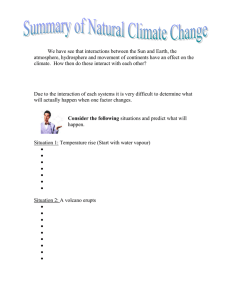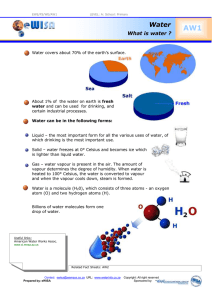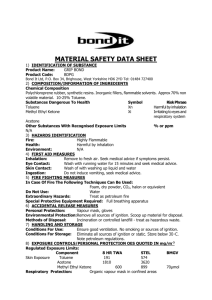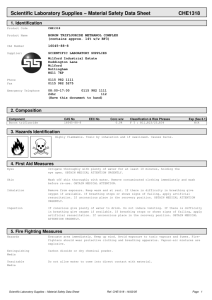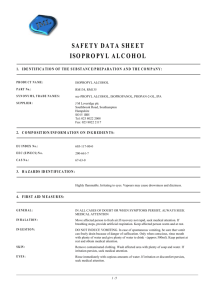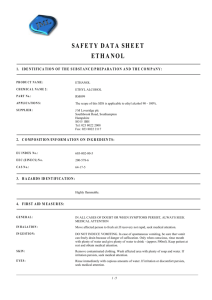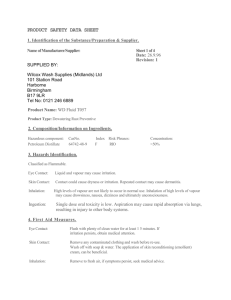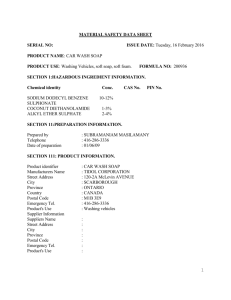painting tips - B and R Supreme Paints
advertisement
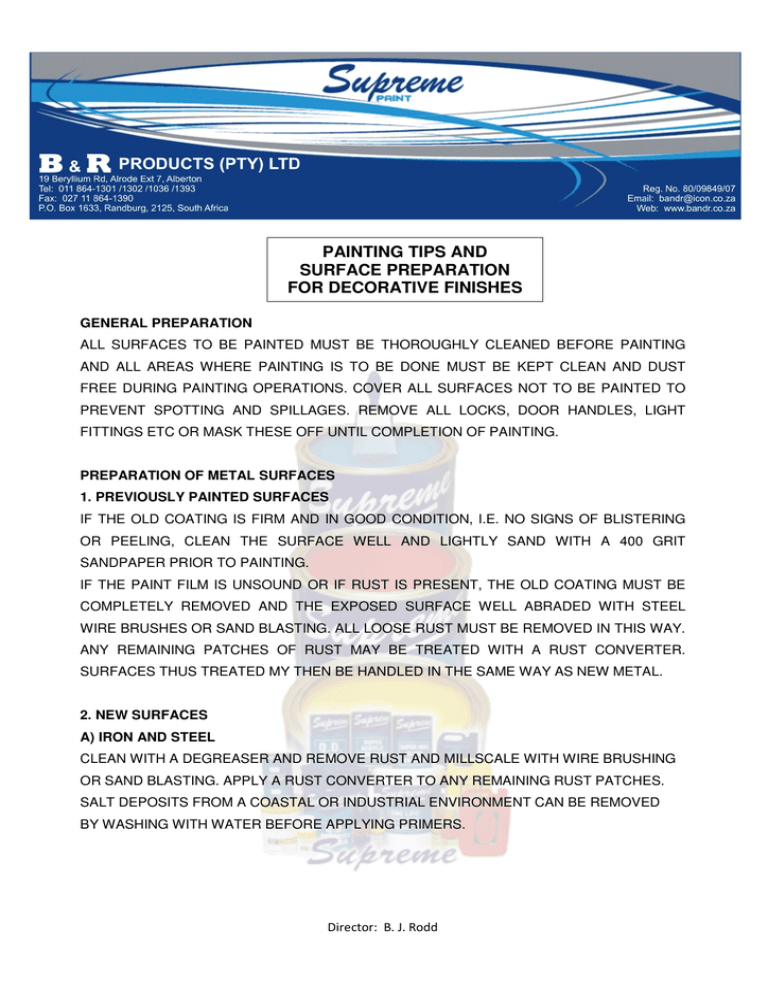
PAINTING TIPS AND SURFACE PREPARATION FOR DECORATIVE FINISHES GENERAL PREPARATION ALL SURFACES TO BE PAINTED MUST BE THOROUGHLY CLEANED BEFORE PAINTING AND ALL AREAS WHERE PAINTING IS TO BE DONE MUST BE KEPT CLEAN AND DUST FREE DURING PAINTING OPERATIONS. COVER ALL SURFACES NOT TO BE PAINTED TO PREVENT SPOTTING AND SPILLAGES. REMOVE ALL LOCKS, DOOR HANDLES, LIGHT FITTINGS ETC OR MASK THESE OFF UNTIL COMPLETION OF PAINTING. PREPARATION OF METAL SURFACES 1. PREVIOUSLY PAINTED SURFACES IF THE OLD COATING IS FIRM AND IN GOOD CONDITION, I.E. NO SIGNS OF BLISTERING OR PEELING, CLEAN THE SURFACE WELL AND LIGHTLY SAND WITH A 400 GRIT SANDPAPER PRIOR TO PAINTING. IF THE PAINT FILM IS UNSOUND OR IF RUST IS PRESENT, THE OLD COATING MUST BE COMPLETELY REMOVED AND THE EXPOSED SURFACE WELL ABRADED WITH STEEL WIRE BRUSHES OR SAND BLASTING. ALL LOOSE RUST MUST BE REMOVED IN THIS WAY. ANY REMAINING PATCHES OF RUST MAY BE TREATED WITH A RUST CONVERTER. SURFACES THUS TREATED MY THEN BE HANDLED IN THE SAME WAY AS NEW METAL. 2. NEW SURFACES A) IRON AND STEEL CLEAN WITH A DEGREASER AND REMOVE RUST AND MILLSCALE WITH WIRE BRUSHING OR SAND BLASTING. APPLY A RUST CONVERTER TO ANY REMAINING RUST PATCHES. SALT DEPOSITS FROM A COASTAL OR INDUSTRIAL ENVIRONMENT CAN BE REMOVED BY WASHING WITH WATER BEFORE APPLYING PRIMERS. Director: B. J. Rodd GENERAL SOLVENT 1. HAZARDS IDENTIFICATION Highly flammable Explosive air/vapour mixtures may form at ambient temperature. Vapour is heavier than air and may travel to remote sources of ignition (e.g. along drainage systems, in basements etc.) Abuse involving wilful inhalation of very high concentrations of vapour, even for short periods, can produce unconsciousness or might prove fatal. Harmful if swallowed – aspiration hazard. Harmful by inhalation and skin contact. Likely to cause skin irritation. 2. FIRST-AID MEASURES Eyes Wash eye thoroughly with copious quantities of water, ensuring eyelids are held open. Obtain medical advice if any pain or redness develops or persists. Skin Wash skin thoroughly with soap and water as soon as reasonably practicable. Remove heavily contaminated clothing and wash underlying skin. In extreme situations of saturation with this product, drench with water, remove clothing as soon as possible and wash skin with soap and water. Seek medical advice if skin becomes red, swollen or painful. Ingestion If contamination of the mouth occurs, wash out thoroughly with water. Except as a deliberate act, the ingestion of large amounts of product is unlikely. If it should occur, do not induce vomiting; obtain medical advice. Director: B. J. Rodd Inhalation If exposure to vapour, mists or fumes causes drowsiness, headache, blurred vision or irritation of the eyes, nose or throat, remove immediately to fresh air. Keep patient warm and at rest. If any symptoms persist obtain medical advice. Unconscious casualties must be placed in the recovery position. Monitor breathing and pulse rate and if breathing has failed, or is deemed inadequate, respiration must be assisted, preferably by the mouth to mouth method. Administer external cardiac massage if necessary. Seek medical attention immediately. Medical Advice Treatment should in general be symptomatic and directed to relieving any effects. Product can be aspirated on swallowing or following regurgitation of stomach contents, and can cause severe and potentially fatal chemical pneumontis, which will require urgent treatment. Because of the risk of aspiration, induction of vomiting and gastric lavage should be avoided. Gastric lavage should be undertaken only after endotracheal intubation. Monitor for cardiac dysrhythmias. 3. FIRE-FIGHTING MEASURES For major fires call the Fire Service. Ensure an escape path is always available from any fire. There is a danger of flashback if sparks or hot surfaces ignite vapour. Use foam, dry powder or water fog. DO NOT USE water jets. Fires in confined spaces should be dealt with by trained personnel wearing approved breathing apparatus. Any spillage should be regarded as a potential fire risk. Combustion Products Toxic fumes may be evolved on burning or exposure to heat. See Stability and Reactivity, Section 10 of this Safety Data Sheet. 4. ACCIDENTAL RELEASE MEASURES As this product has a very low flash point any spillage or leak is a severe fire and/or explosion hazard. Isolate spillage from all ignition sources including road traffic. Ensure good ventilation. Evacuate all non-essential personnel from the immediate area. Director: B. J. Rodd Wear protective clothing. See Exposure Controls/Personal Protection, section 8, of this Safety Data Sheet. Recovery of large spillages should be effected by specialized personnel. It is advised that stocks of suitable absorbent material should be held in quantities sufficient to deal with any spillage which may be reasonably anticipated. Contain and recover spilled material using sand or other suitable inert absorbent material. Small quantities of spilled liquid may be allowed to evaporate. Vapour should be dispersed by effective ventilation. Protect drains from potential spills to minimize contamination. Do not wash product into drainage system. Vapour is heavier than air and may travel to remote sources of ignition (eg. Along drainage systems, in basements etc.). If spillage has occurred in a confined space, ensure adequate ventilation and check that a safe, breathable atmosphere is present before entry. In the case of spillage on water, prevent the spread of product by the use of suitable barrier equipment. Recover product from the surface. Protect environmentally sensitive areas and water supplies. In the event of spillages contact the appropriate authorities. Regular surveillance on the location of the spillage should be maintained. 5. HANDLING AND STORAGE Storage Conditions Store and dispense only in well ventilated areas away from heat and sources of ignition. Store and use in equipment/containers designed for use with this product. Containers must be properly labeled and kept closed when not in use. Do not remove warning labels from containers. Empty packages may contain some remaining product. Retain hazard warning labels on empty packages as a guide to the safe handling, storage and disposal or empty packaging. Handling Precautions Avoid contact with skin and observe good personal hygiene. Director: B. J. Rodd Avoid contact with eyes. If splashing is likely to occur wear a full face visor or chemical goggles as appropriate. Do not siphen product by mouth. Whilst using do not eat, drink or smoke. Fire Prevention Light hydrocarbon vapours can build up in the headspace of tanks. These can cause flammability/explosion hazards even at temperatures below the normal flash point (note: flash point must not be regarded as a reliable indicator or the potential flammability of vapour in tank headspaces). Tank headspaces should always be regarded as potentially flammable and care should be taken to avoid static electrical discharge and all ignition sources during filling, ullaging and sampling from storage tanks. When the product is pumped (eg. During filling, discharge or ullaging) and when sampling, there is a risk of static discharge. Ensure equipment used is properly earthed or bonded to the tank structure. Explosive air/vapour mixtures may form at ambient temperature. Product contaminated rags, paper or material used to absorb spillages, represent fire hazard, and should not be allowed to accumulate. Dispose of safely immediately after use. Empty containers represent a fire hazard as they may contain some remaining flammable product and vapour. Never cut, weld, solder or braze empty containers. 6. EXPOSURE CONTROLS/PERSONAL PROTECTION Exposure Limits If vapour, mists or fumes are generated, their concentration in the workplace air should be controlled to the lowest reasonably practicable level. Comply with current local occupational exposure limit. Protective Clothing Wear face visor or goggles in circumstances where eye contact can accidentally occur. If skin contact is likely, wear impervious protective clothing and/or gloves. Protective clothing should be regularly inspected and maintained; overalls should be dry-cleaned, Director: B. J. Rodd laundered and preferably starched after use. Respiratory Protection If operations are such that exposure to vapour, mist or fume may be anticipated, then suitable approved respiratory equipment should be worn. The use of respiratory equipment must be strictly in accordance with the manufacturers’ instructions and any statutory requirements governing its selection and use. 7. STABILITY AND REACTIVITY Stable at ambient temperatures. Hazardous polymerization reactions will not occur. Conditions to Avoid Sources of ignition. Avoid excessive heat. Materials to Avoid Avoid contact with strong oxidizing agents. Hazardous Decomposition Products Thermal decomposition products will vary with conditions. Incomplete combustion will generate smoke, carbon dioxide and hazardous gases, including carbon monoxide. 8. TOXICOLOGICAL INFORMATION Eyes May be irritating to the eyes. Skin Harmful in contact with skin. Likely to cause skin irritation. Likely to result in chemical burns following prolonged wetting of the skin (eg. After a road traffic accident). Director: B. J. Rodd Ingestion Unlikely to cause harm if accidentally swallowed in small doses, through larger quantities may cause nausea and diarrhoea. Will injure lungs if aspiration occurs, eg. During vomiting. Inhalation Harmful if vapour, mists or fumes generated during use are inhaled. Likely to be irritating to the respiratory tract if high concentrations of mists or vapour are inhaled. May cause nausea, dizziness, headaches and drowsiness if high concentrations of vapour are inhaled. ABUSE: Under normal conditions of use the product is not hazardous; however, abuse involving deliberate inhalation of very high concentrations of vapour, even for short periods, can produce unconsciousness and/or result in a sudden fatality. 9. ECOLOGICAL INFORMATION Mobility Spillages may penetrate the soil causing ground water contamination. Persistence and degradability This product is inherently biodegradable. Bioaccumulative potential There is no evidence to suggest bioaccumulation will occur. Aquatic toxicity Spills may form a film on water surfaces causing physical damage to organisms. Oxygen transfer could also be impaired. Harmful to aquatic organisms. 10. DISPOSAL CONSIDERATIONS Dispose of via an authorized person/licensed waste disposal contractor in accordance with local regulations. Empty packages may contain some remaining product. Hazard warning labels are a guide to the safe handling of empty packaging and should not be removed. Director: B. J. Rodd Empty containers represent a fire hazard as they may contain flammable product residues and vapour. Never weld, solder or braze empty containers. Materials contaminated with product should be treated as highly flammable. Disposal should be in accordance with local regulations. 11. REGULATORY INFORMATION EU Category of Danger Highly flammable Harmful Irritant EU Labelling Symbol: Flame, St. Andrew’s Cross Indication of danger: HIGHLY FLAMMABLE, HARMFUL, IRRITANT Risk ( R ) Phrases: R11 Highly flammable R20/21 Harmful by inhalation and in contact with skin R38 Irritating to skin R65 Harmful: may cause lung damage if swallowed. Safety ( S ) Phrases: S2 Keep out of reach of children S16 Keep away from sources of ignition – No smoking S23 Do not breathe vapours S24/25 Avoid contact with skin and eyes S29 Do not empty into drains S33 Take precautionary measures against static discharges S62 If swallowed, do not induce vomiting: seek medical advice immediately and show this container or label. Director: B. J. Rodd
